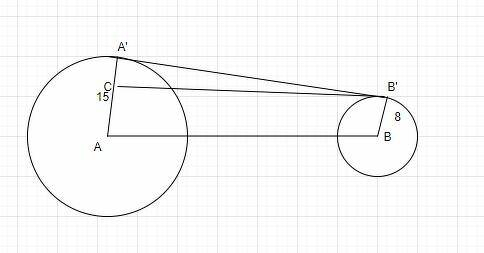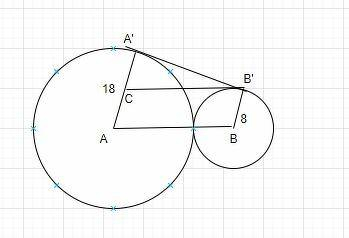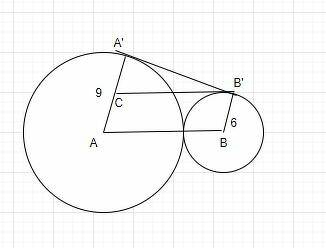Answer:
19) 24 units.Step-by-step explanation:
19.

GIVEN: AA' = 15 units, BB' = 8 units and AB = 25 units.
To find: A'B'
Draw B'C = AB (ABB'C is a parallelogram)
Therefore, AC = BB' = 8 units.
CA' = 15 - 8 = 7 units.
A'CB' is a right angle traingle with B'C hypotenuse.
Using the Pythagorean theorem, we can calculate the length of the common external tangent (the side opposite to the right angle):
B'C^2 = A'B'^2 + A'C^2
25^2 = A'B'^2 + 7^2
A'B'^2 = 625 - 49 = 576
A'B' = √576 = 24 units.
Thus, the length of the common tanget = 24 units
20.

GIVEN: AA' = 18 cm, BB' = 8 cm and AB = 18+8 = 26 cm.
To find: A'B'
Draw B'C = AB (ABB'C is a parallelogram)
Therefore, AC = BB' = 8 cm.
CA' = 18 - 8 = 10 cm.
A'CB' is a right angle traingle with B'C hypotenuse.
Using the Pythagorean theorem, we can calculate the length of the common external tangent (the side opposite to the right angle):
B'C^2 = A'B'^2 + A'C^2
26^2 = A'B'^2 + 10^2
A'B'^2 = 676 - 100 = 576
A'B' = √576 = 24 cm
Thus, the length of the common tanget = 24 cm
21.

GIVEN: AA' = 9 cm, BB' =6 cm and AB = 9+6 = 15 cm.
To find: A'B'
Draw B'C = AB (ABB'C is a parallelogram)
Therefore, AC = BB' = 6 cm.
CA' = 9 - 6 = 3 cm.
A'CB' is a right angle traingle with B'C hypotenuse.
Using the Pythagorean theorem, we can calculate the length of the common external tangent (the side opposite to the right angle):
B'C^2 = A'B'^2 + A'C^2
15^2 = A'B'^2 + 3^2
A'B'^2 = 225 - 9 = 216
A'B' = √216 = 14.696 cm = 14.7 cm
Thus, the length of the common tanget = 14.7 cm